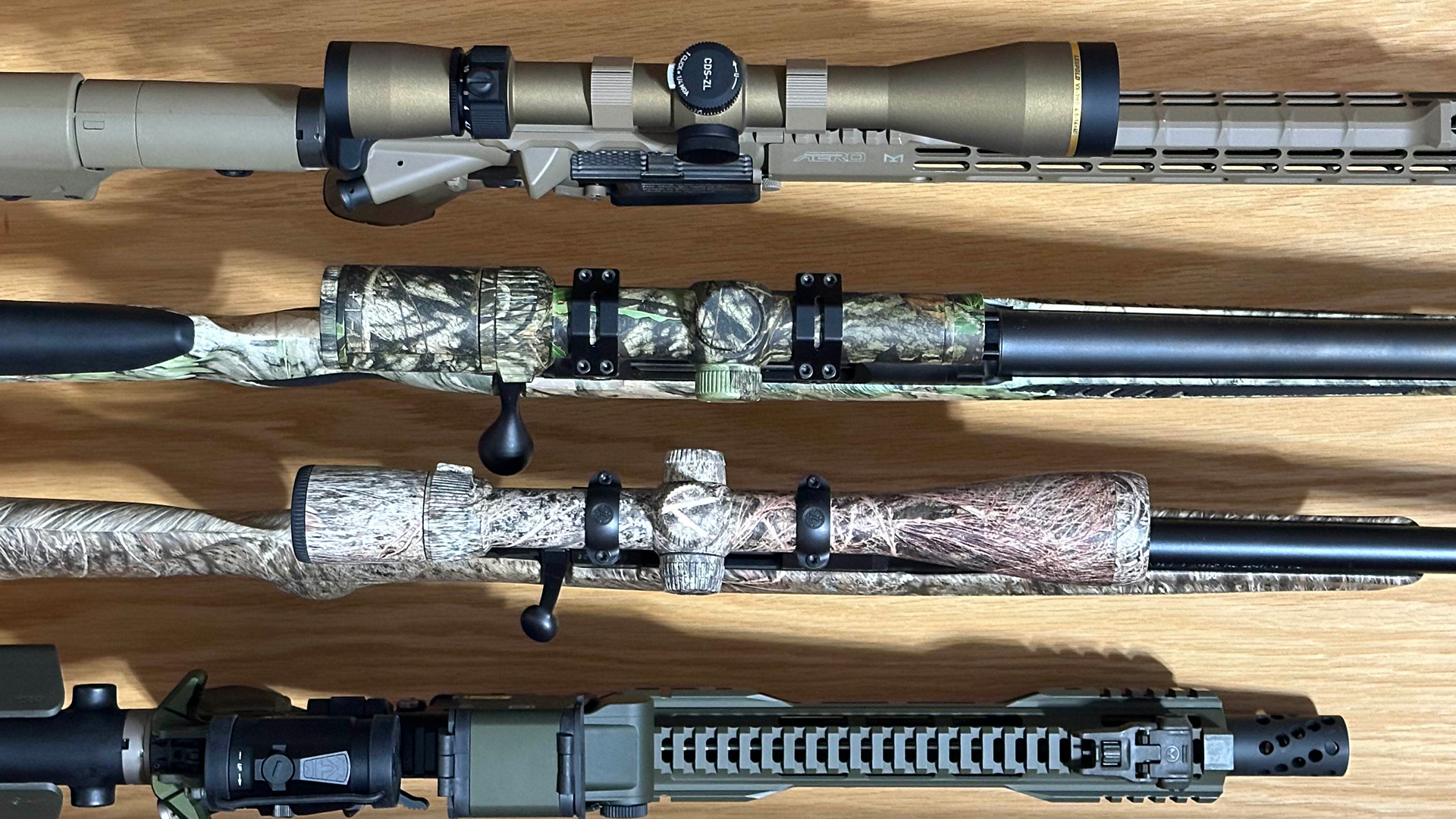
There’s a lot of talk regarding optic finishes, mostly to do with what’s on the inside such as lenses and their respective coatings. The same can be said of metal finishes on firearms, primarily barrels and actions. What’s not being discussed very often are the external metal finishes on riflescopes. You may think that’s not important, but these finishes have many secondary purposes that may not influence shots, but can influence what qualifies as a “success” when in the field. So, what differences can a scope’s external finish make?
Concealability
Hunters know this one all too well. Ask a turkey hunter, for instance, why they paint their faces, or the whitetail hunter why they hide in a blind or up on a treestand. And if you know any special forces personnel or military snipers, talk to them about their schooling, specifically SERE (Survive, Evade, Resist, Escape) training, and they’ll tell you how crucial it is to hide yourself and break up your outline. And that goes for every piece of equipment, be it with a simple color scheme to blend into the surroundings, manufacturing camouflage with fabrics and foliage to produce a three-dimensional effect, or simply removing items with pure black to prevent extreme contrast of color an area of natural greens, yellows or browns. Matching the environment is defined as “blending,” which is the term used in the Department of the Army’s Sniper Training and Employment manual (1989) and can be done both through natural and artificial means, the latter of which would include scope finishes. Though dated, the manual states, “Paying close attention to camouflage fundamentals is a mark of a well-trained sniper.” The manual goes on to define “improper camouflage” as “shine, outline, [and] contrast with the background.”
But don’t take my word, a hunter’s word or an outdated manual for it. Sergeant First Class (SFC) Brandon Sloan, a seven-year U.S. Army sniper and marksmanship instructor, explained, “Manmade objects are almost always made to be symmetrical and with perfectly straight lines. In nature, there are no perfect lines. Being able to conceal your scope is just as—if not more—important as camouflaging your body or position. It’s important to break up the cylindrical shape of your scope to prevent any detection, reflection, or shine. Having some type of natural colors to break up the black finish, while also having any type of irregular pattern to disrupt the silhouette of the scope, is a must.” SFC Sloan gave an example of how important a rifle's scope concealment can be. “As the observer … I’ve had snipers go undetected without a ghillie suit, just by properly camouflaging their rifles and scopes.”

Corroborating SFC Sloan’s statements about concealment, Jon LaCorte at TRACT Optics stated, “Black isn’t a color found in nature.” TRACT Optics are known to have a non-black, graphite color on all their optics. It’s a signature color palette found on the company’s optics, partially for that very reason.
Taking it a step farther than just “not black”, there are a few classic examples of legitimate camo patterns being used on early 2000s riflescopes. Nikon made a Coyote Special scope finished in Mossy Oak Brush, and Weaver made a turkey-hunting specific scope finished in Mossy Oak Obsession. I’ve got one of each, with the former mounted on a Browning X-Bolt in .22-250 and the latter mounted on a Savage bolt-action 12-gauge. Both rifles wear the same respective camo on their stocks.
Protection
Scopes are made of metal, just like many other components of a gun. But it’s not the same steel found in barrels or receivers. Typically, most scopes are made of an aluminum alloy. While aluminum alloys are strong, they’re not the same kind of “strong” as stainless steel. That said, not only will a finish on a scope help hide the scope from prying eyes, but a scope’s finish will also help protect the scope. External finishes on scopes do vary, typically, because of the materials used in making scope bodies. An anodized finish is often used (Type III anodizing is what’s used on most scopes) on aluminum, which provides protection via an electrochemical process. Sometimes, when adding chemicals to a compound, compromises can occur. However, this isn’t true when adding colors to the anodizing mix to get a desired finish, meaning that scope tubes, when finished with a hard anodizing, even when colored, don’t lose any protection.
TRACT Optics’ Jon LaCorte mentioned to me that its scopes, which are finished in the company's signature matte graphite blue, exhibit no compromise when it comes to adding some color to a scope. Jon also mentioned Cerakote is an option, but it’s more costly, and because of the aluminum of the scope body, Jon—with his experience both at Nikon and now at TRACT Optics—has never seen a scope rust; back in the '60s and '70s, when scopes were made of steel, that could’ve been an problem, but not now. This lack of rust potential therefore makes Cerakote unnecessary, and why anodizing works just fine for colorized protection.
That said, knowing there’s no compromise to the finish’s protection qualities, there’s no reason to settle for a black scope when you could have any color you want. This is why Leupold, SIG Sauer, Nightforce Optics and Vortex Optics, among others, make scopes with several different finish options.
Aesthetics
There’s an element of aesthetics to a gun's optic important to many of us; matching a scope finish to the gun's color theme always looks great. For instance, the four companies I listed above all make a Flat Dark Earth (FDE)-color scope, which looks great when paired with gun of FDE color. Consumers like color options; look no farther than the automobile industry for proof of individuality in its products. And then there's the “shock and awe” factor when removing a color-coordinated gun from its case at the range and others nearby begin to notice. I’ve personally color coordinated a custom AR build with an Olive Drab Green optic from EOTech for merely aesthetic value. Aside from rifles, we see this trend in the handgun market, too, with many FDE handguns color-matched red-dots.

In speaking further with LaCorte, he mentioned another reason why TRACT Optics went with its signature color. Many modern guns, aesthetically speaking, have a lot of gray tones in the stocks and metal finishes, which tend to match TRACT's color pattern, keeping the brand modern and relevant in a visually appealing sense, not just functionally. If you can keep ahead of the trend, you're better for it, and TRACT scopes look excellent, as do many of the colored scopes from other manufacturers.
Status
Similar to this idea of aesthetics is the status symbol that comes with coordinated camouflage, especially when using top-tier patterns from brands such as Kuiu, First Lite or Sitka. For instance, Kimber made the Mountain Ascent rifles—Kimber’s top-end rifle line, which were the lightest commercial rifles available at the time–in a couple different Sitka patterns. Kimber partnered with Leupold, Zeiss and Talley Manufacturing to offer patterns on scopes, as well as rings and bases, to compliment the entire rifle, and more than likely, the hunter’s clothing, too. Kimber still makes the Mountain Ascent rifle, of course, just with a different camo pattern. Except now the company doesn't offer color-coordinated scopes, rings and bases as previously offered. You'd have to do that on your own today.

All of these aforementioned points raise the question: If you enjoy your fancy camo, why would you not include it on your firearm and optic, especially if given the opportunity to do so without the high cost of extreme custom work? Matching camo across the board ties all of this together by concealing you and your gear better, protecting your equipment from the elements, and it just looks good. Sure, an argument can still be made that a black optic, in all reality, still does its job. After all, camo or colors on a scope tube don’t change your scope’s magnification ranges, your scope’s objective lens size, or your scope’s eye relief. That said, a custom finish might just make the difference you never knew you needed.




































